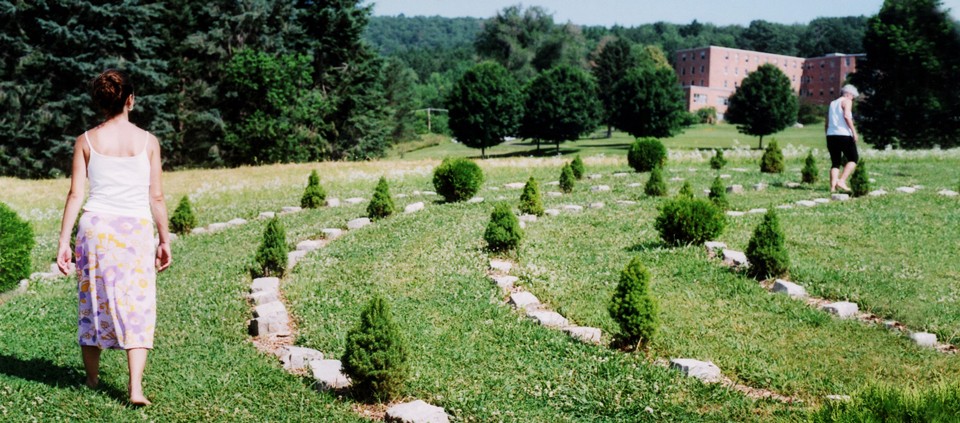Walking in Circles: The Lore of the Labyrinth

I have a fear of getting lost—on back roads, on unmarked trails, in shopping malls—of being swept up and away from familiar markers into settings that are terrifyingly unfamiliar (forbidden forests, Victoria’s Secret stores). For this reason, I love maps of all kinds. I treasure my GPS. I like to know what lies ahead.
It seems counterintuitive that I would enjoy labyrinths, which are so often depicted as bewildering, malevolent places. See The Shining, Harry Potter and the Goblet of Fire, and Pan’s Labyrinth. At best, impenetrable hedges loom above eye level and fog machines churn out swampy mist. Make a wrong turn and you could end up in David Bowie’s puppet lair (Labyrinth). These spooky associations likely stem from Greek mythology, in which King Minos commissioned the craftsman Daedalus to build a labyrinth, wishing to trap the monstrous Minotaur—half man, half bull.
But these are not actually labyrinths. They’re mazes, with many options and choices, known as multicursal. A genuine labyrinth contains only one path (unicursal). As long as I keep going, I’ll end up back at the beginning. No GPS required.
Labyrinths have existed for at least 4,000 years, as evidenced in pottery fragments, ancient graffiti, and stone carvings throughout Southern Europe, in rock pilings near the White and Baltic Seas, in prehistoric petroglyphs in India, and in Hopi Native American culture, where labyrinths have long represented Mother Earth.
In Chartres Cathedral, near Paris, the medieval floor engraving (circa 1200) allows pilgrims to walk as an act of devotion. In Britain, from the mid-1800s until World War I, garden labyrinths served as playgrounds for children and "places for dalliance by young lovers," says Jeff Saward, author of Magical Paths: Labyrinths and Mazes in the 21st Century. The first recorded hedge labyrinth in the United States (1815, in Harmony, Pennsylvania) signified the spiritual quest of the Harmonists, religious objectors displaced from their native Germany.
Today, labyrinths are increasingly common in hospitals, spas, and prisons, where they are used as a form of gentle, calming exercise. Simply tracing the outline of a labyrinth on paper can be a soothing practice to counteract anxiety. For some, the seven circuits of the classical design recall the seven chakras in yoga philosophy.
“There are revivals of interest in labyrinths that occur throughout history,” says David Gallagher, executive director of the Labyrinth Society. They tend to be popular during times of upheaval. According to the Worldwide Labyrinth locater, where you can search by zip code, there are now 3,983 labyrinths in the United States. Included in that number is the beautiful seven-path classical design at Kripalu, conceived and built in 2001 by Kripalu Schools faculty member Sudha Carolyn Lundeen and Kripalu Grounds Supervisor Kevin “Moose” Foran.
“I’d wanted to build one on campus for a while,” says Sudha, “I know that many guests come to Kripalu seeking clarity and connection to their deepest self, wanting to feel renewed and strengthened when they head back out into the world. The labyrinth stands ready and welcoming to all, a living reminder that when we’re weary and feeling lost, all that is required of us is that we put one foot in front of the other and carry on.”
Since then, the pine bushes that line the spiraling path—which arrived for planting in one-gallon pots—have become full-fledged trees. The surrounding wildflowers, which bloom from spring until fall, include lupines, oxeye daises, rudbeckia daisies, coreopsis, and Sweet William. Moose estimates that ten thousand people visit the labyrinth each year, in all seasons.
Walking the labyrinth is a chance to notice the changing seasons in the features of the landscape—and the vacillations in my own busy brain. First I pause at the entrance and breathe deeply. I close my eyes and notice smells, sounds, sensations, thoughts. I dedicate my walk to someone. Or I pose a question. (Perhaps an answer will arise as I go.) Sometimes I have no questions. I simply try to stay present and observe the rhythm of my steps. I leave an offering in the center (a leaf, pine cone, or stone), the place where the Minotaur once dwelled. I find no monster, just evidence of previous visitors.
At the labyrinth, there’s only one decision to make—whether or not to enter. I can walk during times of confusion or celebration, in inquiry or meditation, and I know I’ll never get lost.
Lara Tupper, MFA, a writer, singer, and teacher, leads Labyrinth Walks at Kripalu. laratupper.com
© Kripalu Center for Yoga & Health. All rights reserved. To request permission to reprint, please e-mail editor@kripalu.org.
Lara Tupper, MFA, is the author of two novels, Off Island and A Thousand and One Nights, and Amphibians, a linked short story collection forthcoming in 2021.
Full Bio and Programs